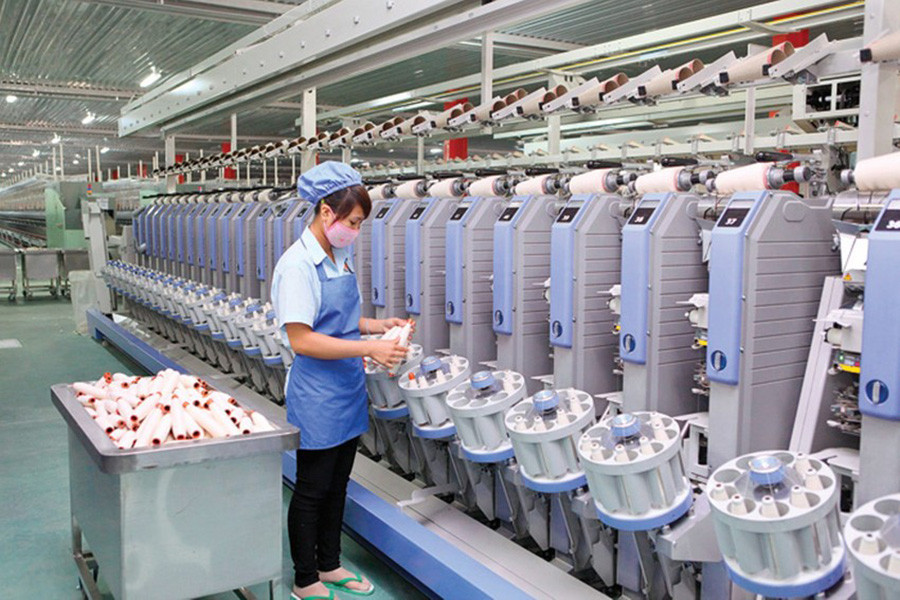
In terms of investment, Vietnam has asked China to develop big projects using modern technology according to agreements between the two countries to avoid slow implementation.
Chinese leaders pledged to encourage investors with high ability and high tech to invest and do business in Vietnam, and to work with Vietnam to settle problems in economic and trade cooperation.
According to the Ministry of Planning and Investment (MPI), China’s investment in Vietnam has reached $1.7 billion, the fourth largest foreign investor out of 103 countries and territories. Several large Chinese invested projects capitalized at hundreds of millions of dollars have been registered, including a solar panel manufacturing project in Quang Chau Industrial Zone (IZ) in Bac Giang province; ACTR steel radian tire project; and $220 million Billion Vietnam polyester and synthetic fiber in Tay Ninh.
In 2017, the two sides signed important documents on economic and trade cooperation, production capability connections, BRI connections with "Two Corridors, One Belt" (TCOB) and cross-border economic cooperation.
In the field of trade, at the talks of high-ranking leaders, China promised to balance trade development; encourage Chinese enterprises to import more of Vietnam’s competitive products; create favorable conditions for Vietnam to establish more trade promotion offices in China; and settle problems in the economic and trade relations between the two countries.
Since late 2013, the two countries have signed nearly 30 agreements and documents related to investment and trade.
To facilitate the goods clearance process and infrastructure connections in border areas, customs procedure facilitation has been implemented in recent years. There are thousands of goods container trucks that cross Vietnam-China border gates. In 2016-2018, three pairs of subordinate border gates were upgraded into major border gates.
Railway connections were marked by the opening of two container freight trains in late 2017 – Hanoi - Dong Dang to Guangxi and Jiangxi, and Hai Phong to Yunnan.
During bilateral talks, Vietnam proposed reducing its trade deficit with many short-term and long-term, direct and indirect solutions, such as:
China needs to create favorable conditions to strengthen full-tax trade, complete legal procedures on market opening to Vietnam’s fruit;
Vietnam’s farm produce should not be exported to China mostly through unofficial channels, which pose high risks and instability;
Complete procedures to upgrade and open new pairs of border gates to satisfy the requirements;
And, facilitate the implementation of activities of Vietnam’s trade promotion offices in Chongqing and Hangzhou;
Vietnam’s ministries, branches and localities need to be more proactive in promoting economic and trade cooperation with China and satisfy requirements in quality and technical standards.
In 2015, Vietnam established a trade promotion office in Chongqing. In 2016, 22 Vietnam’s rice producers and processors got a license to export to China through an official quota. In 2017, two famous Vietnamese coffee and milk brands officially entered the Chinese market.
The 2022 Joint Statement once again emphasized trade development in a safe, healthy, balanced and favorable manner. The Chinese side will speed up the market opening process for Vietnam’s cassava, citrus fruits, salangane nests and some kinds of farm produce, while the Vietnamese side will accelerate the market opening to China’s dairy products.
Since September 8, 2022, Vietnam has had the right to export durian to China through official channels. To date, 10 Vietnam’s types of fruits have had a license to go to China through official channels. The procedures for market opening to purple sweet potatoes and salangane nests are in the final stage.
Vietnamese agencies have also asked China to open its market to other types of fruit, including passion fruit, pomelo, rose-apple and custard-apple.
On the occasion of the Vietnamese Party Committee Secretary General Nguyen Phu Trong’s visit to China, a protocol on phytosanitary requirements for fresh bananas exported from Vietnam to China was signed, paving the way for bananas to be officially exported to China in the future.
Promoting cultural, educational cooperation
In joint statements, the two sides show their respect for the need to strengthen communication and cooperation related to education and people-to-people communications.
Regarding education, the Chinese government grants scholarships to Vietnamese citizens to fund their higher education courses. In 2021, China granted 44 full scholarships to Vietnamese citizens to study for bachelor’s, master’s and doctoral degrees in China. About 11,000 Vietnamese students are studying at universities in China and 2,000 Chinese students are studying in Vietnam.
During the Vietnamese Party Chief’s Nguyen Phu Trong’s visit to China, the Chinese side committed to provide no fewer than 1,000 scholarships to Vietnam in the next five years and no fewer than 1,000 scholarships to teachers of Chinese language.
Fifty cities and provinces of Vietnam have established friendship relations with cities, provinces and autonomous regions of China.
Phuong Nguyen